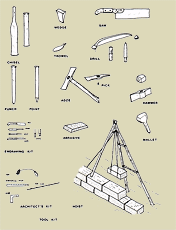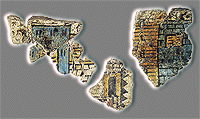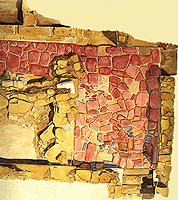 Rocks of various colours were used in the construction of Minoan buildings
which resulted in the polychrome appearance, both outside and in.
The main material for the walls was hewn
limestone domes. Less common building materials included conglomerate rocks,
local soft limestone (kouskouras) and slate.
Gypsum was mainly used in the construction of luxurious buildings.
Both the outside and inside walls were built of stone domes, while stone slabs
were used to construct doorways.
Various kinds of marble were used in the decoration of smaller areas
of floors, column bases and stone revetments. The material used to join
the domes was clay mixed with rubble, shells and straw. The outside walls (which
required greater skill than the inside ones)
were usually sealed with earth clay. The
inside walls were covered with coloured limestone plaster and decorated with
high quality frescoes in the most important quarters.
Rocks of various colours were used in the construction of Minoan buildings
which resulted in the polychrome appearance, both outside and in.
The main material for the walls was hewn
limestone domes. Less common building materials included conglomerate rocks,
local soft limestone (kouskouras) and slate.
Gypsum was mainly used in the construction of luxurious buildings.
Both the outside and inside walls were built of stone domes, while stone slabs
were used to construct doorways.
Various kinds of marble were used in the decoration of smaller areas
of floors, column bases and stone revetments. The material used to join
the domes was clay mixed with rubble, shells and straw. The outside walls (which
required greater skill than the inside ones)
were usually sealed with earth clay. The
inside walls were covered with coloured limestone plaster and decorated with
high quality frescoes in the most important quarters.
 In the construction of walls a large proportion of wood was used, although timber
was scarce in Crete. Wood ensured the elasticity of the buildings and consequently its
protection against earthquakes. Wood was used mainly in the construction of
columns, runners and niches and as an abutment of the roof and floors. The staircases
were usually made of wood too, while wooden wall revetments was employed as a
cheap dado substitute. Although no such wooden sections have survived, they are
often represented in art in great detail.
In the construction of walls a large proportion of wood was used, although timber
was scarce in Crete. Wood ensured the elasticity of the buildings and consequently its
protection against earthquakes. Wood was used mainly in the construction of
columns, runners and niches and as an abutment of the roof and floors. The staircases
were usually made of wood too, while wooden wall revetments was employed as a
cheap dado substitute. Although no such wooden sections have survived, they are
often represented in art in great detail.
 Floors were very colourful, as stone plaques were combined with coloured plaster
or cobbled surfaces. The ground floors were often covered with gravel while
the spaces created between the plaques were covered with perishable materials.
Although there is insufficient evidence for the use of other materials, it is considered very
likely that metals were also used in building, and that textiles were used for the
covering of the polythyra.
Floors were very colourful, as stone plaques were combined with coloured plaster
or cobbled surfaces. The ground floors were often covered with gravel while
the spaces created between the plaques were covered with perishable materials.
Although there is insufficient evidence for the use of other materials, it is considered very
likely that metals were also used in building, and that textiles were used for the
covering of the polythyra.